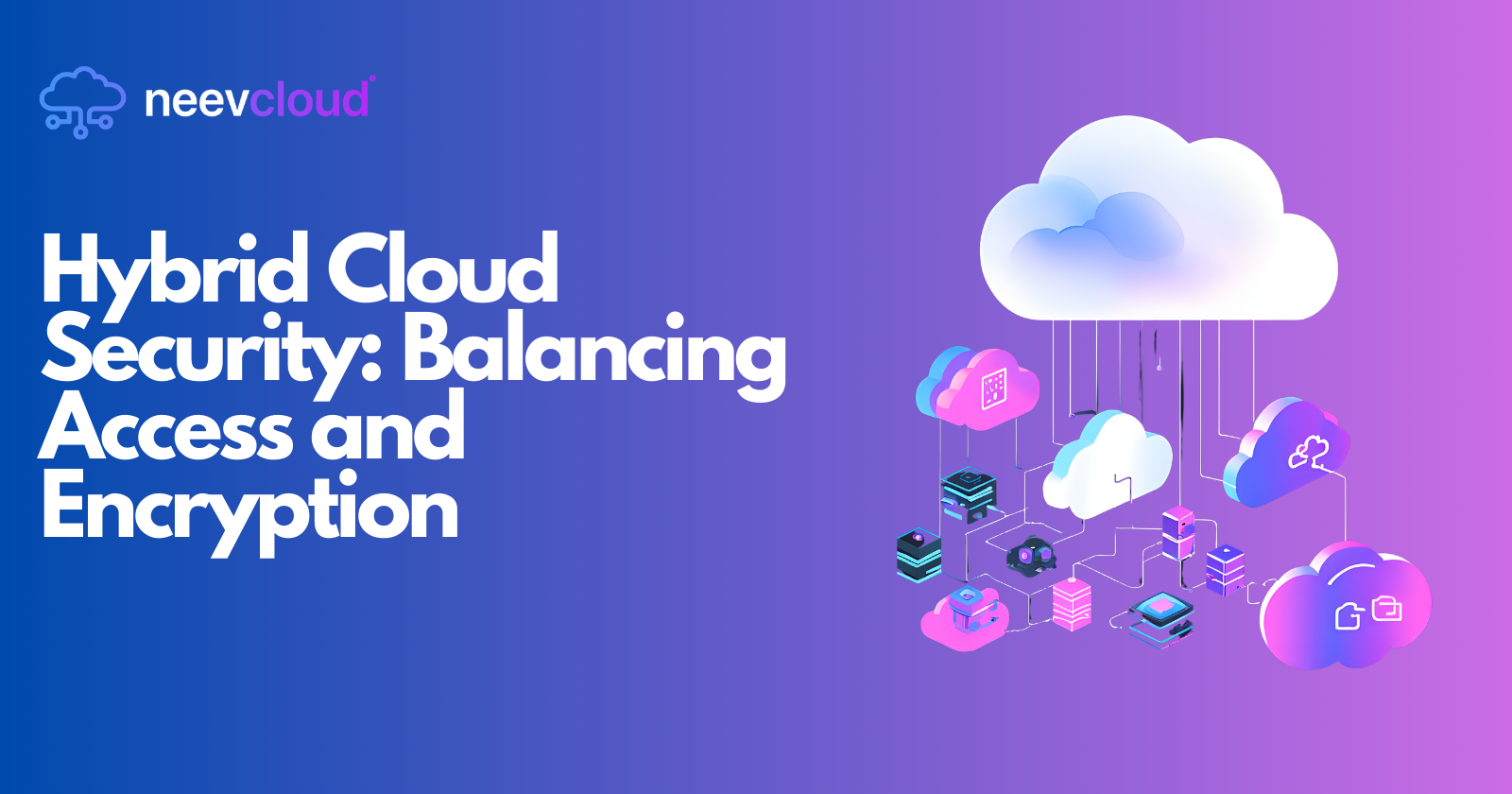Hybrid Cloud Security: Balancing Access and Encryption
 Tanvi Ausare
Tanvi Ausare
Introduction
The rise of hybrid cloud architecture has created an essential paradigm shift in IT operations and data management strategies, allowing organizations to combine the flexibility of public cloud resources with the security and control of private data centers. In today’s AI-driven world, hybrid clouds support an array of applications, from Cloud GPUs for AI model training to real-time Cloud AI processing. However, the dual nature of the hybrid environment brings security challenges: how to balance accessibility for efficiency with encryption for safety? Below, we explore key strategies for managing security in hybrid cloud environments, focusing on balancing accessibility with robust encryption to safeguard data.
1. Understanding the Security Risks in Hybrid Cloud Environments
Data Transit Vulnerabilities: With data continuously moving between AI Datacenters, public clouds, and edge devices, transit vulnerabilities become a critical risk. Encrypting data in motion is vital to protect against interception or eavesdropping.
Complex Access Control: Hybrid clouds often mean handling multiple access points, user permissions, and authentication methods, making consistent access control policies challenging.
Interoperability Challenges: Integrating diverse platforms, such as AI Cloud, Cloud GPUs, and on-prem AI Datacenters, can introduce security gaps that attackers might exploit.
Increased Surface Area for Attacks: With resources spread across public and private infrastructures, the overall attack surface widens, creating more points of vulnerability.
2. Essential Security Elements in Hybrid Cloud
Data Encryption: Encrypting data at rest, in transit, and during processing is essential. AES-256 and other advanced encryption protocols help safeguard sensitive information.
Identity and Access Management (IAM): Unified IAM controls help manage access and permissions across cloud environments, reducing unauthorized access.
Regular Security Audits and Monitoring: Proactive monitoring across both public and private segments of the hybrid cloud is essential for real-time threat detection.
AI-Powered Threat Detection: Leveraging AI within Cloud AI frameworks for security threat detection helps identify anomalies and potential breaches in real-time.
3. Best Practices for Balancing Accessibility and Encryption
Adopt a Zero-Trust Architecture: Ensures that only authenticated and authorized users have access, preventing lateral movement by attackers.
Encrypt All Data at Multiple Levels: Employ encryption not just at data storage points but also during computation, ensuring robust protection.
Implement Role-Based Access Controls (RBAC): Limit access based on user roles and responsibilities to reduce unnecessary exposure to critical systems.
Use Hybrid Cloud Gateways: Secure data flow between public and private clouds with dedicated gateways that provide end-to-end encryption and control.
4. Leveraging Cloud GPU for Secure AI Processing
Isolated Processing Environments: Cloud GPUs can isolate workloads and ensure that sensitive AI data is processed securely without cross-interference.
Enhanced Data Encryption on AI Datacenters: Specialized GPUs on the cloud can support encryption-focused AI computations, securing sensitive processing tasks.
Real-Time Data Analytics and Threat Detection: Cloud GPUs enable high-speed data analysis, which can be used for monitoring threats and anomalies across hybrid environments.
5. Enhancing Data Security with Edge AI in Hybrid Cloud
Localized Data Processing: Edge AI allows data to be processed locally, reducing the need for data transfers across public and private networks.
AI-Driven Encryption Mechanisms: Edge AI can apply on-device encryption before data is transmitted, reducing the risk of data exposure during transit.
Improved Compliance: Localized processing aligns with data sovereignty regulations by keeping sensitive information closer to its point of origin.
6. Encryption Techniques for Hybrid Cloud Security
Symmetric vs. Asymmetric Encryption: Symmetric encryption is faster for bulk data but requires secure key management, whereas asymmetric encryption, while slower, can be ideal for secure key exchanges across public networks.
Homomorphic Encryption for AI Computations: Enables data to be processed while encrypted, allowing sensitive information to remain secure throughout AI model training on Cloud GPUs.
Data Masking and Tokenization: Use data masking and tokenization to obfuscate sensitive data, adding a layer of security while allowing authorized access for processing tasks.
7. Security Compliance in Hybrid Cloud Environments
GDPR, HIPAA, and CCPA Requirements: Encrypt data in compliance with relevant regulations, ensuring that the data handling aligns with standards for privacy and security.
Compliance Automation Tools: Use AI-powered compliance tools within the AI Datacenter to continually assess and maintain regulatory compliance.
Data Residency and Sovereignty: In hybrid cloud environments, ensure that data is stored in regions compliant with local laws, which might involve using private datacenters for sensitive workloads.
8. AI-Powered Security Solutions for Hybrid Cloud Environments
AI Cloud Security Models: Machine learning models can detect anomalies across public and private cloud segments, identifying unusual access patterns or potential breaches.
Automated Response Mechanisms: With AI-powered automation, the hybrid cloud can instantly respond to threats, isolating affected components and mitigating potential damages.
User Behavior Analytics: AI can analyze user behaviors across hybrid clouds to flag unusual access or potential account compromises.
AI-Based Malware Detection: AI and Cloud GPU resources can work together to process large datasets for malware signatures, keeping systems free from harmful files.
9. Challenges in Implementing Encryption at Scale
Resource Constraints: Encrypting large volumes of data can strain Cloud GPU resources, especially during high-load periods.
Latency and Performance: While encryption adds security, it also adds computational overhead, potentially impacting performance for time-sensitive applications.
Complex Key Management: Managing encryption keys across a hybrid cloud environment requires centralized and secure solutions, which may increase operational complexity.
10. Tools and Technologies for Hybrid Cloud Security
Dedicated Hardware Security Modules (HSMs): Offer secure key management and cryptographic operations for critical hybrid cloud applications.
Cloud-Based Key Management Services (KMS): Most cloud providers offer KMS solutions for managing encryption keys, facilitating encryption across environments.
AI Datacenter Monitoring Solutions: Tools like DCGM can monitor GPU health and performance metrics, adding a layer of security and reliability to Cloud GPU operations.
Multi-Factor Authentication (MFA): MFA across hybrid cloud systems reduces the likelihood of unauthorized access, safeguarding critical applications and data.
11. Case Study: AI Cloud Deployment with Hybrid Security
Scenario Overview: An organization deploying an AI Cloud solution across a hybrid cloud setup, with sensitive customer data processed using Cloud GPUs.
Challenge: Balancing high accessibility for real-time processing with encryption protocols that maintain data confidentiality.
Solution: The organization adopts a multi-layered encryption approach with AI-powered access management to dynamically adjust permissions based on data sensitivity and user roles.
Outcome: This approach ensures secure, efficient data processing and storage while minimizing unauthorized access risks and adhering to regulatory standards.
12. Future Directions in Hybrid Cloud Security
Quantum-Resistant Encryption: As quantum computing advances, hybrid clouds will require encryption resistant to quantum attacks, ensuring long-term data security.
Enhanced AI Threat Intelligence: Future hybrid cloud environments may incorporate more sophisticated AI models to preemptively detect and neutralize emerging security threats.
Federated Learning for Distributed Security: Federated learning allows for AI model training across distributed data sources without data transfer, adding another layer of data security for hybrid clouds.
Conclusion
As businesses increasingly leverage hybrid cloud environments for advanced AI, managing security becomes a top priority. By balancing accessibility with encryption, organizations can secure their hybrid clouds without compromising functionality. Hybrid cloud security must evolve to meet emerging challenges, combining encryption protocols, AI-driven threat detection, and robust access management to protect sensitive data and applications.
Subscribe to my newsletter
Read articles from Tanvi Ausare directly inside your inbox. Subscribe to the newsletter, and don't miss out.
Written by
